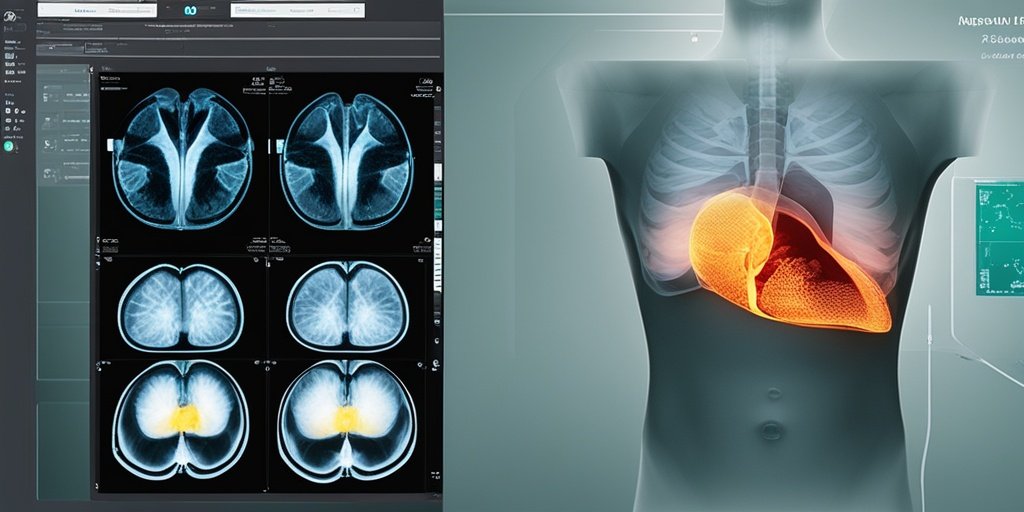⚡ Quick Summary
The study introduces a novel method called EGGPALE for emphasizing abnormal lesions in chest radiographs, validated by nine radiologists using 1,000 chest X-rays. This method demonstrated a +0.0559 improvement in sensitivity while slightly affecting specificity, showcasing its potential in enhancing lung cancer detection.
🔍 Key Details
- 📊 Dataset: 1,000 chest X-rays, including positive and negative lung cancer cases
- 🧩 Features used: Normal chest radiographs for training
- ⚙️ Technology: Flow-based generative model with L-infinity-distance extrapolation
- 🏆 Performance: Sensitivity improved by +0.0559; specificity decreased by -0.0192
🔑 Key Takeaways
- 🖼️ EGGPALE is a general-purpose method for emphasizing abnormal lesions in chest X-rays.
- 👨⚕️ Validation involved nine radiologists interpreting 1,000 chest X-rays.
- 📈 Sensitivity of EGGPALE-processed images showed a statistically significant improvement.
- 📉 Specificity experienced a slight deterioration, indicating a trade-off.
- 🔬 Computed tomography was used to validate positive and negative cases.
- 🌟 The area under the receiver operating characteristic curve improved significantly with EGGPALE.
- 💻 Code availability: The method’s code can be accessed at GitHub.

📚 Background
The detection of lung nodules in chest radiographs is crucial for early lung cancer diagnosis. Traditional methods often struggle with sensitivity and specificity, leading to missed diagnoses or unnecessary follow-ups. The introduction of advanced machine learning techniques, such as generative models, offers a promising avenue for enhancing the visibility of abnormal lesions, potentially improving diagnostic accuracy.
🗒️ Study
This study aimed to validate the effectiveness of the EGGPALE method in emphasizing abnormal lesions in chest X-rays. Conducted with nine radiologists, the evaluation involved a comprehensive analysis of 1,000 chest X-rays, which included both suspected lung cancer cases and confirmed negative cases validated through computed tomography.
📈 Results
The results indicated that the EGGPALE-processed images achieved an average sensitivity improvement of +0.0559 compared to the original images. However, there was a slight decrease in specificity, with an average deterioration of -0.0192. Notably, the area under the receiver operating characteristic curve for the ensemble of nine radiologists showed a statistically significant enhancement, validating the method’s feasibility for clinical use.
🌍 Impact and Implications
The findings from this study suggest that EGGPALE could significantly enhance the detection of lung nodules in chest radiographs, potentially leading to earlier diagnosis and treatment of lung cancer. As healthcare continues to integrate advanced technologies, methods like EGGPALE could play a vital role in improving diagnostic accuracy and patient outcomes in radiology.
🔮 Conclusion
The study highlights the promising capabilities of the EGGPALE method in emphasizing abnormal lesions in chest radiographs. With demonstrated improvements in sensitivity and significant validation from radiologists, this approach could pave the way for enhanced lung cancer detection. Continued research and development in this area are essential for realizing the full potential of generative models in medical imaging.
💬 Your comments
What are your thoughts on the use of generative models in radiology? We would love to hear your insights! 💬 Share your comments below or connect with us on social media:
Deep generative abnormal lesion emphasization validated by nine radiologists and 1000 chest X-rays with lung nodules.
Abstract
A general-purpose method of emphasizing abnormal lesions in chest radiographs, named EGGPALE (Extrapolative, Generative and General-Purpose Abnormal Lesion Emphasizer), is presented. The proposed EGGPALE method is composed of a flow-based generative model and L-infinity-distance-based extrapolation in a latent space. The flow-based model is trained using only normal chest radiographs, and an invertible mapping function from the image space to the latent space is determined. In the latent space, a given unseen image is extrapolated so that the image point moves away from the normal chest X-ray hyperplane. Finally, the moved point is mapped back to the image space and the corresponding emphasized image is created. The proposed method was evaluated by an image interpretation experiment with nine radiologists and 1,000 chest radiographs, of which positive suspected lung cancer cases and negative cases were validated by computed tomography examinations. The sensitivity of EGGPALE-processed images showed +0.0559 average improvement compared with that of the original images, with -0.0192 deterioration of average specificity. The area under the receiver operating characteristic curve of the ensemble of nine radiologists showed a statistically significant improvement. From these results, the feasibility of EGGPALE for enhancing abnormal lesions was validated. Our code is available at https://github.com/utrad-ical/Eggpale.
Author: [‘Hanaoka S’, ‘Nomura Y’, ‘Hayashi N’, ‘Sato I’, ‘Miki S’, ‘Yoshikawa T’, ‘Shibata H’, ‘Nakao T’, ‘Takenaga T’, ‘Koyama H’, ‘Cho S’, ‘Kanemaru N’, ‘Fujimoto K’, ‘Sakamoto N’, ‘Nishiyama T’, ‘Matsuzaki H’, ‘Yamamichi N’, ‘Abe O’]
Journal: PLoS One
Citation: Hanaoka S, et al. Deep generative abnormal lesion emphasization validated by nine radiologists and 1000 chest X-rays with lung nodules. Deep generative abnormal lesion emphasization validated by nine radiologists and 1000 chest X-rays with lung nodules. 2024; 19:e0315646. doi: 10.1371/journal.pone.0315646